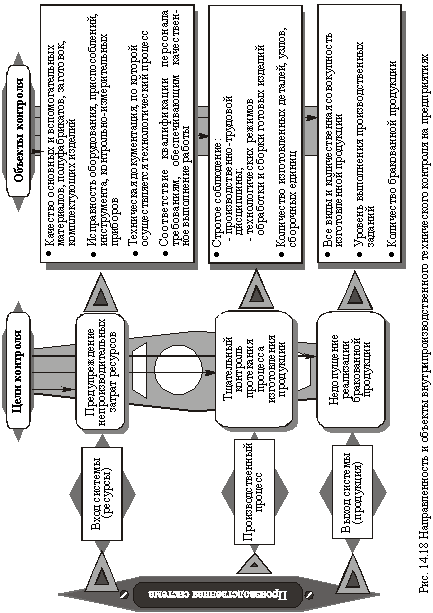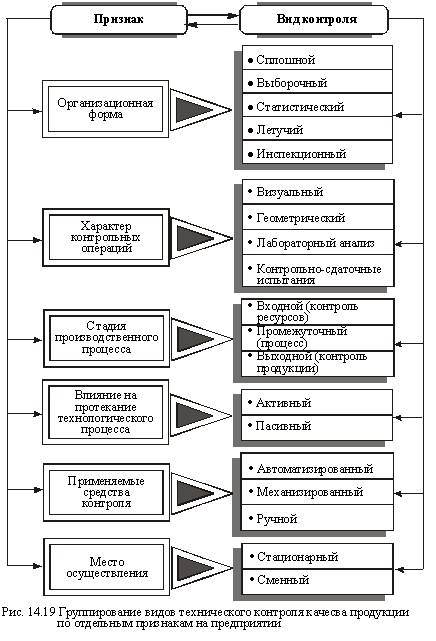home
 Economy Economy
 Business Economics - Pokropivny SF Business Economics - Pokropivny SF
|
Business Economics - Pokropivny SF
14.6. State supervision of the internal activity kachestvomi technical control
The most important methods of ensuring the quality and competitiveness of production belong to the state supervision and technical control internal activity.
State supervision over product quality
In Ukraine, it has been largely established system of standardization and certification of products (services). Currently, the national body that conducts and coordinates efforts to ensure its functioning, is the State Committee for Standardization and Certification (Gosstandart of Ukraine). For the organization of the development, assessment and preparation for approval of state standards of Ukraine on the decision of the State Standard of established technical standardization committees, which operate under a contract with the National organom.K work in the committees involved on a voluntary basis, representatives of interested companies and organizations, leading scientists and experts. The main functions of the State Standard of Ukraine in the field of certification of work are:
- defining the principles, structure and rules of the certification system;
- approval of the list of products subject to mandatory certification;
- accreditation of certification bodies and testing laboratories (centers), certification ekspertov- auditors;
- establish rules of recognition of certificates of other countries;
- constant informing consumers through appropriate information channels regarding the standards of different categories of certificates of technical, economic and social information, test centers, and so on. n.
Within the state of standardization and certification system in Ukraine operates state of the quality of supervision, which is exercised by the relevant authorities. It provides a certain responsibility of business entities for violation of standards, norms (metrology, health, and other mandatory requirements, and the right to establish the maximum allowable value of output indicators, which guarantee high quality) (metrology, health, economic, fire, technological).
State supervision of compliance with standards, rules and regulations carry the State Standard of Ukraine and its territorial bodies - standardization centers, methodology and certification. The first heads of these bodies positions are both the main state inspectors of other managers and specialists - state inspectors, respectively, Ukraine, the Autonomous Republic of Crimea, regions and cities of Quality Supervision product.
The bodies of state supervision performed multidirectional functions, namely: check compliance with the standards (norms and rules), summarize the results of the checks and to inform the relevant public authorities and the public; ensure prompt action to stop the violations of standards (norms and rules), make proposals relating to improving product quality and efficiency of its own activities.
State supervision in the form of a periodic (constant) to verify compliance with the requirements of normative documents or selective (solid) Stability Control certified product quality, product testing rules is carried out according to the plans of supervisory bodies or in the case of applications of citizens with complaints. The objects of state supervision are:
- products for industrial purposes, consumer goods and food - with respect to compliance with the standards, rules and regulations;
- export products - with respect to the standards (rules and regulations), or specific requirements arising from the agreement (contract);
- imported products - about existing in Ukraine standards (norms, rules) safety for life, health, property of people and the environment;
- certified production - on the conformity of the requirements for certification of products.
Business entities for violation of requirements of standards (norms, rules) are a liability - a fine. Depending on the nature of the violation fines are as follows:
- for the output of scientific, technical, industrial, technical and consumer goods, which does not comply with standards or not passed mandatory certification - 25%;
- implementation of increased danger of products without proper warning labeling and appropriate transportation, use (consumption), as well as imported products instructions, which do not meet the requirements of national standards for the safety of life, health, property of people and the environment - 50%;
- selling products forbidden to release the state supervisory authorities, and products that are a result of violations of the standards have become dangerous for life (health) of people and the environment - 100% of their value.
It is important that the payment of fines in the respective amounts shall not relieve employers from damages to consumers of products that have arisen as a result of violations of the standards (norms, rules) or as a result of breach of contract for the supply of products. The amounts of the fines in the amount of 60% shall be included in the state budget and 30% - off-budget funds of local authorities, State Standard receives 10% and uses this amount for their material and technical and scientific research base.
IPLs technical controlAmong the existing and widely used methods to ensure high quality production takes intraproductive technical control of an important position. At the enterprises of direct quality control functions of the main components and finished products for consumption carry out the technical control department (QCD).
The main task of technical control - constantly provide the necessary level of quality, stated in the regulations, by direct inspection of each product and targeted impact on the factors and conditions that ensure such quality. Successfully solving this problem can be with the right choice of objects and methods of control. control facilities should be all of the components of the production system and interconnected with it elements t. e. the input (resources), the production process itself, the output (products). Key ones are shown in Fig. 14.18.
The need to control resources (materials, energy, tools, information, personnel) at the input of the system is illustrated by the fact that their quality largely determines the competitiveness of products. Use in the production process of even a part of poor quality may lead to resource overhead benign resources. In other words, the control objects on the input of the system (enterprise) or some of its production sides (shops, sections) must be: 1) the quality of basic and auxiliary materials, blanks, semi-finished products, components, individual parts and components; 2) repair equipment, tools, working tools and instrumentation, with which manufactured products and is determined by its level of quality; 3) technical documentation, for which the manufacturing process; 4) compliance with the requirements of the skill level of staff, ensuring quality performance of a particular job.
The quality of products is largely formed during the production process itself. This necessitates a careful control of its manufacturing technology. Objects of control here is the level of compliance with production and labor discipline, technological modes of processing and assembly of products. Checks concern not only quality products, but also produced their number, as a violation of the technological, industrial and labor discipline may result in damage to raw materials, individual parts and even finished products, and the gap in the number of manufactured products- to default of the production program of the enterprise.

Control the output of the production system (enterprise and its divisions) should prevent defective products entering the consumer or transfer it to the next phase of the process (stage). This control also allows you to keep the leadership of the level of fulfillment of production targets and the achieved economic results of production.
The level of the cost of quality control and overall effectiveness of such controls depend essentially on the well-founded choice of different methods (types of) quality control (Fig. 14.19.)
The essence of these methods (forms) in most cases is clear based on their names.
Among them are found to be most effective: to influence the course of the process - active; for used tools - automated; organizational forms - statistical.
Active is a quality control directly during the process of manufacturing the product and its processing modes with special reference technical adaptations which have been built into the process equipment (automatic indicators, measuring heads, isotopic, induction and other devices). Application of active control can prevent the emergence and yield of the process of semi-finished and finished kinds of poor quality products.
With automated quality control check is carried out through the use of automated devices (including industrial robots) without human intervention both during the process and after completion of the processing and assembly of the product. Such control is one of the main ways to reduce the costs of control operations and increase their efficiency particularly in the continuous and massive types of production, where the complexity of quality assurance often exceeds the cost of manufacturing the product in automatic mode.

Statistical - is a special form (technique) sampling is based on the application of the theory of probability and mathematical statistics. It allows you to not only capture the actual level of product quality, but also to actively influence the course of the process, to ensure that its regulation (of Control). Its basic principle is that any steady process when no unforeseen failures, actual production-quality copies of the individual will always be only minor deviations from the mean values.
The advantage of statistical control is the ability to control the level of the quality of products on the principle of self-regulation cybernetic feedback system. However, it has its disadvantages and which can not be ignored: firstly, it is relatively narrow in scope (mainly mass production); secondly, it requires a relatively high cost of collecting and processing information. Make cheaper these processes can be achieved by automating the collection, processing and analysis necessary for the control of information, creation of flexible automated production.
Among other types of engineering controls are self-explanatory except that volatile, inspection, fixed and removable control. Flying is called sudden (without warning) and short product quality control (working artists) in certain areas of production. Inspection control is carried out on critical signals, and mainly in the form of a public or in-process supervision. Regular monitoring is carried out in a specially equipped premises (laboratories) with the help of suitable tests, analyzes and so on. N., And smennyy- directly in the workplace by the performers or the control masters (controllers) OTC business.
Questions for self-depth study
- Justification marketing strategy.
- Possible and inappropriate forms of state intervention in the process of defining public demand for production and preparation of the production program in a market economy.
- The general procedure and the specific technique of drawing up a production program of the enterprise in modern economic conditions.
- Selection of suppliers of material and technical resources under market conditions.
- Issues of stockpiling materials and control of those stocks in the company.
- Improving the current system of single and common indicators of product quality in terms of improving the quality and objectivity of reflection to simplify the system.
- The necessity and the methodology for determining the optimal product quality.
- Competitive products: the essential characteristic evaluation methods provide.
- Economic and legal basis of content and the number of state (national) standards for enterprise products.
- Analytical evaluation of the technical level and quality of basic products in key sectors of Ukrainian industry.
- The generalization of foreign experience in the field of quality control and the possibility of its use at the enterprises of Ukraine in creating certified quality systems.
- The system of state supervision over the quality of products manufactured at the enterprises of Ukraine.


Comments
Commenting, keep in mind that the content and the tone of your messages can hurt the feelings of real people, show respect and tolerance to his interlocutors, even if you do not share their opinion, your behavior in terms of freedom of speech and anonymity offered by the Internet, is changing not only virtual, but real world. All comments are hidden from the index, spam control.